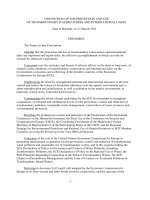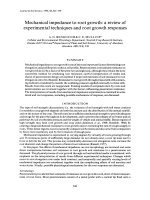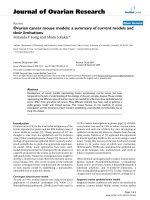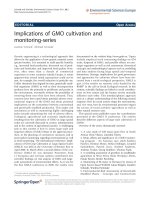Essentials of control techniques and Keyword Stats_6 doc
Bạn đang xem bản rút gọn của tài liệu. Xem và tải ngay bản đầy đủ của tài liệu tại đây (1.3 MB, 27 trang )
148 ◾ Essentials of Control Techniques and Theory
favorite. Soon time-domain and pseudo-random binary sequence (PRBS) test methods
were adding to the confusion—but they have no place in this chapter.
11.2 The Nyquist Plot
Before looking at the variety of plots available, let us remind ourselves of the object
of the exercise. We have a system that we believe will benefit from the application of
feedback. Before “closing the loop,” we cautiously measure its open loop frequency
response (or transfer function) to ensure that the closed loop will be stable. As a
bonus, we would like to be able to predict the closed loop frequency response.
Now if the open loop transfer function is G(s), the closed loop function will be
Gs
Gs
()
()1+
(11.1)
is is deduced as follows. If the input is U(s) and we subtract the output Y(s) from
it in the form of feedback, then the input to the “inner system” is U(s) − Y(s). So
YS GS US YS() (){()()}= −
i.e.,
{()} () () ()1+=Gs Ys GsUs
so
Ys
Gs
Gs
Us()
()
()
()=
+1
We saw that stability was a question of the location of the poles of a system,
with disaster if any pole strayed to the right half of the complex frequency plane.
Where will we find the poles of the closed loop system? Clearly they will lie at the
Phase shift near zero
(a) (b)
Phase shift 90°
Figure 11.1 Oscilloscope measurement of phase.
91239.indb 148 10/12/09 1:44:22 PM
More Frequency Domain Methods ◾ 149
values of s that give G(s) the value −1. e complex gain (−1 + j0) is going to become
the focus of our attention.
If we plot the readings from the phase-sensitive voltmeter, the imaginary part
against the real with no reference to frequency, we have a Nyquist plot. It is the path
traced out in the complex gain plane as the variable s takes value jω, as ω increases
from zero to infinity. It is the image in the complex gain plane of the positive part
of the imaginary s axis.
Suppose that
Gs
s
()=
+
1
1
then
Gj
j
j
j
()ω
ω
−ω
ω
ω
−
ω
ω
=
+
=
+
=
+
1
1
1
1
1
11
2
22
+
If G is plotted in the complex plane as u + jv, then it is not hard to show that
uvu
22
0+=−
is represents a circle, though for “genuine” frequencies with positive values of
ω we can only plot the lower semicircle, as shown in Figure 11.2. e upper half of
the circle is given by considering negative values of ω. It has a diameter formed by
the line joining the origin to (1 + j0). What does it tell us about stability?
Clearly the gain drops to zero by the time the phase shift has reached 90°, and
there is no possible approach to the critical gain value of −1. Let us consider some-
thing more ambitious.
e system with transfer function
Gs
ss s
()
()()
=
++
1
11
(11.2)
has a phase shift that is never less than 90° and approaches 270° at high frequen-
cies, so it could have a genuine stability problem. We can substitute s = jω and
manipulate the expression to separate real and imaginary parts:
Gj
jj
()
()
ω
ω−ωω
=
+
1
12
2
So multiplying the top and bottom by the conjugate of the denominator, to make
the denominator real, we have
Gj
j
()
()
()
ω
ωωω
ωω
=
−− −
+
21
1
22
222
91239.indb 149 10/12/09 1:44:24 PM
150 ◾ Essentials of Control Techniques and Theory
e imaginary part becomes zero at the value ω = 1, leaving a real part with value
−1/2. Once again, algebra tells us that there is no problem of instability. Suppose
that we do not know the system in algebraic terms, but must base our judgment on
the results of measuring the frequency response of an unknown system. e Nyquist
diagram is shown in Figure 11.3. Just how much can we deduce from it?
Since it crosses the negative real axis at −0.5, we know that we have a gain mar-
gin of 2. We can measure the phase margin by looking at the point where it crosses
the unit circle, where the magnitude of the gain is unity.
Nyquist plot
Figure 11.3 Nyquist plot of 1/s(s + 1)
2
. (Screen grab from www.esscont.com/11/
nyquist2.htm)
Nyquist plot
Figure 11.2 Nyquist plot of 1/(1 + s). (Screen grab from www.esscont.com/11/
nyquist.htm)
91239.indb 150 10/12/09 1:44:26 PM
More Frequency Domain Methods ◾ 151
11.3 Nyquist with M-Circles
We might wish to know the maximum gain we may expect in the closed loop system.
As we increase the gain, the frequency response is likely to show a “resonance” that
will increase as we near instability. We can use the technique of M-circles to predict
the value, as follows.
For unity feedback, the closed loop output Y(jω) is related to the open loop
gain G(jω) by the relationship
Y
G
G
=
+1
(11.3)
Now Y is an analytic function of the complex variable G, and the relationship
supports all the honest-to-goodness properties of a mapping. We can take an inter-
est in the circles around the origin that represent various magnitudes of the closed
loop output, Y. We can investigate the G-plane to find out which curves map into
those constant-magnitude output circles.
We can rearrange Equation 11.3 to get
YYGG+=
so
G
Y
Y
=
−1
By letting Y lie on a circle of radius m,
Ym j=+(cos sin)θθ
we discover the answer to be another family of circles, the M-circles, as shown in
Figure 11.4. is can be shown algebraically or simply by letting the software do
the work; see www.esscont.com/mcircle.htm.
Q 11.3.1
By letting G = x + jy, calculating Y, and equating the square of its modulus to m, use
Equation 11.3 to derive the equation of the locus of the M-circles in G.
We see that we have a safely stable system, although the gain peaks at a value
of 2.88.
We might be tempted to try a little more gain in the loop. We know that
doubling the gain would put the curve right through the critical −1 point, so some
smaller value must be used. Suppose we increase the gain by 50%, giving an open
loop gain function:
Gs
ss
()
.
()
=
+
15
1
2
91239.indb 151 10/12/09 1:44:29 PM
152 ◾ Essentials of Control Techniques and Theory
In Figure 11.5 we see that the Nyquist plot now sails rather closer to the critical
−1 point, crossing the axis at −0.75, and the M-circles show there is a resonance
with closed loop gain of 7.4.
M = 0.8
M = 0.4
M = 0.2
M-circles
M = 2
M = 3
M = 4
M = 5
M = 6
Figure 11.5 Nyquist with higher gain and M-circles. (Screen-grab from www.
esscont.com/11/mcircle2.htm)
M = 2
M = 0.8
M = 0.4
M = 0.2
M-circles
M = 3
M = 4
M = 5
M = 6
Figure 11.4 M-circles.
91239.indb 152 10/12/09 1:44:31 PM
More Frequency Domain Methods ◾ 153
11.4 Software for Computing the Diagrams
We have tidied up our software by making a separate file, jollies.js, of the rou-
tines for the plotting applet. We can make a further file that defines some useful
functions to handle the complex routines for calculating a complex gain from
a complex frequency. We can express complex numbers very simply as two-
component arrays.
e contents of complex.js are as follows. First we define some variables to use.
en we define functions to calculate the complex gain, using functions to copy,
subtract, multiply, and divide complex numbers. We also have a complex log func-
tion for future plots.
var gain=[0,0]; // complex gain
var denom=[1,0]; // complex denominator for divide
var npoles; // number of poles
var poles = new Array(); // complex values for poles
var nzeros; // number of zeroes
var zeros = new Array(); // complex values for zeroes
var s=[0,0]; // complex frequency, s
var vs=[0,0]; // vector s minus pole or s minus zero
var temp=0;
var k=1; // Gain multiplier for transfer
function
function getgain(s){ // returns complex gain for complex s
gain= [k,0]; // Initialise numerator
for(i=0;i<nzeros; i++){
csub(vs,s,zeros[i]); // ds = s-zero[]
cmul(gain,vs); // multiply vectors for numerator
}
denom= [1,0]; // initialise denominator
for(i=0;i<npoles; i++){
csub(vs,s,poles[i]);
cmul(denom,vs); // multiply vectors from poles
}
cdiv(gain,denom); // divide numerator by denominator
}
function copy(a,b) {// complex b = a
b[0]=a[0];
b[1]=a[1];
}
function csub(a,b,c){ // a = b-c
a[0]=b[0]-c[0];
a[1]=b[1]-c[1];
}
function cmul(a,b){ // a = a * b
temp=a[0]*b[0]-a[1]*b[1];
91239.indb 153 10/12/09 1:44:31 PM
154 ◾ Essentials of Control Techniques and Theory
a[1]=a[0]*b[1]+a[1]*b[0];
a[0]=temp;
}
function cdiv(a,b){ // a = a / b
temp=a[0]*b[0]+a[1]*b[1];
a[1]=a[1]*b[0]-a[0]*b[1];
a[0]=temp;
temp=b[0]*b[0]+b[1]*b[1];
a[0]=a[0]/temp;
a[1]=a[1]/temp;
}
function clog(a){ // a = complex log(a)
temp=a[0]*a[0]+a[1]*a[1];
temp=Math.log(temp)/2;
a[1]=Math.atan2(a[1],a[0]);
a[0]=temp;
}
e code does not require very much editing to change it to give the other
examples.
11.5 The “Curly Squares” Plot
Can we use the open loop frequency response to deduce anything about the closed
loop time-response to a disturbance? Surprisingly, we can.
Remember that the plot shows the mapping into the G-plane of the jω axis of
the s-plane. It is just one curve in the mesh that would have to be drawn to represent
the “mapped graph-paper” effect of Figure 10.1. Remember also that the squares of
the coordinate grid of the s-plane must map into “curly squares” in the G-plane.
Let us now tick off marks along the Nyquist curve to represent equal increments
in frequency, say of 0.1 radians per second, and build onto these segments a mosaic
of near-squares. We will have an approximation to the mapping not only of the
imaginary axis, but also of a “ladder” formed by the imaginary axis, by the vertical
line −0.1 + jω, and with horizontal “rungs” joining them at intervals of 0.1j, as
shown in Figure 11.6.
Now we saw in Section 7.7 that the response to a disturbance will be made up
of terms of the form exp(pt), where p is a pole of the overall transfer function—
and in this case we are interested in the closed loop response. e closed loop gain
becomes infinite only when G = −1, and so any value of s which maps into G = −1
will be a pole of the closed loop system.
Looking closely at the “curved ladder” of our embroidered Nyquist plot, we see
that the −1 point lies just below the “rung” of ω = 0.9, and just past half way across it.
We can estimate reasonably accurately that the image of the −1 point in the s-plane
91239.indb 154 10/12/09 1:44:32 PM
More Frequency Domain Methods ◾ 155
has coordinates −0.055 + j 0.89. We therefore deduce that a disturbance will result
in a damped oscillation with frequency 0.89 radians per second and decay time
constant 1/0.055 = 18 seconds.
(If you are worried that poles should come in complex conjugate pairs, note that
the partner of the pole we have found here will lie in the corresponding image of the
negative imaginary s axis, the mirror image of this Nyquist plot, which is usually
omitted for simplicity.)
Q 11.5.1
By drawing “curly squares” on the plot of G(s) = 1/(s(s + 1)
2
) (Figure 11.3), estimate the
resonant frequency and damping factor for unity feedback when the multiplying gain
is just one. Note that the plot will be just 2/3 of the size of the one in Figure 11.6.
(Algebra gives s = − 0.122 + j 0.745. You could simply look at Figure 11.6 and see
where the point (−1.5,0) falls in the curly mesh!).
Q 11.5.2
Modify the code of Nyquist2.htm to produce the curly squares plot. Look at the
source of ladder.htm to check your answer. Why has omega/10 been used?
11.6 Completing the Mapping
With mappings in mind, we can be a little more specific about the conditions for
stability. We can regard the plot not just as the mapping of the positive imaginary
s axis, but of a journey outward along the imaginary axis. As s moves upward in the
example of Figure 11.3, G move from values in the lower left quadrant in toward
the G-plane origin. As it passes the −1 point, it lies on the left-hand side of the path,
Ladder of curly
squares - frequencies
1
0.9
(b)
0.8
0.7
0.6
Ladder of curly squares
1
0.9
(a)
0.8
0.7
0.6
Figure 11.6 Curly squares and rungs for 1.5/(s(s + 1)
2
). (Screen grabs from www.
esscont.com/11/ladderfreq.htm and www.esscont.com/11/ladder.htm)
91239.indb 155 10/12/09 1:44:33 PM
156 ◾ Essentials of Control Techniques and Theory
implying from the theory of complex functions that s leaves the corresponding pole
on the left-hand side of the imaginary axis—the safe side.
We can extend this concept by considering a journey in the s-plane upwards
along the imaginary axis to a very large value, then in a clockwise semicircle enclos-
ing the “dangerous” positive half-plane, and then back up the negative imaginary
axis to the origin. In making such a journey, the mapped gain must not encircle
any poles if the system is to be stable. is results in the requirement that the
“ completed” G-curve must not encircle the −1 point.
If G becomes infinite at s = 0, as in our present example, we can bend the
journey in the s-plane to make a small anticlockwise semicircular detour around
s = 0, as shown in Figure 11.7.
11.7 Nyquist Summary
We have seen a method of testing an unknown system, and plotting the in-phase and
quadrature parts of the open loop gain to give an insight into closed loop behavior.
We have not only a test for stability, by checking to see if the −1 point is passed on
the wrong side, but an accurate way of measuring the peak gains of resonances.
What is more, we can in many cases extend the plot by “curly squares” to obtain an
estimate of the natural frequency and damping factor of a dangerous pole.
is is all performed in practice without a shred of algebra, simply by plotting
the readings of an “R & Q” meter on linear graph-paper, estimating closed loop
gains with the aid of pre-printed M-circles.
11.8 The Nichols Chart
e R & Q meter lent itself naturally to the plotting of Nyquist diagrams, but sup-
pose that the gain data was obtained in the more “traditional” form of gain and
A
C
D
Gain
plane
B
s-plane
A
C
B
D
Figure 11.7 Nyquist plot for 1/(s(1 + s)
2
) “completed” with negative frequencies.
91239.indb 156 10/12/09 1:44:34 PM
More Frequency Domain Methods ◾ 157
phase, as used in the Bode diagram. Would it be sensible to plot the logarithmic
gain directly, gain against the phase-angle, and what could be the advantages?
We have seen that an analytic function has some useful mathematical properties.
It can also be shown that an analytic function of an analytic function is itself ana-
lytic. Now the logarithm function is a good honest analytic function, where
log( ())logGs Gj G=+(| |) arg( ).
(Remember that the function “arg” represents the phase-angle in radians, with value
whose tangent is Imag(G)/Real(G). e atan2 function, taking real and imaginary
parts of G as its input parameters, puts the result into the correct quadrant of the
complex plane.)
Instead of plotting the imaginary part of G against the real, as for Nyquist,
we can plot the logarithmic gain in decibels against the phase shift of the system.
All the rules about encircling the critical point where G = −1 will still hold, and we
should be able to find the equivalents of M-circles.
e point G = −1 will of course now be defined by a phase shift of π radians or
180°, together with a gain of 0 dB. e M-circles are circles no longer, but since the
curves can be pre-printed onto the chart paper, that is no great loss. e final effect
is shown in Figure 11.8.
So what advantage could a Nichols plot have over a Nyquist diagram?
M = 0.4
M = 0.2
M = 0.8
M = 1.6
M = 3.2
M = 6.4
–270–90
M-circles
Figure 11.8 Nichols chart for 1/(s(s + 1)
2
). (Screen grab of www.esscont.com/11/
nichols.htm)
91239.indb 157 10/12/09 1:44:36 PM
158 ◾ Essentials of Control Techniques and Theory
Suppose that we wish to consider a variety of gains applied before the open
loop transfer function input, as defined by k in Figure 11.9. To estimate the result-
ing closed loop response, we might have to rescale a Nyquist diagram for each
value considered. Changing the gain in a Nichols plot, however, is simply a mat-
ter of moving the plot vertically with respect to the chart paper. By inspecting
Figure 11.8 it is not hard to estimate the value of k, for instance, which will give a
peak closed loop gain of 3.
When more sophisticated compensation is considered, such as phase-advance,
the Nichols chart relates closely to the Bode diagram and the two can be used
together to good effect.
11.9 The Inverse-Nyquist Diagram
ere is an alternative to the Nyquist diagram that maintains simplicity while
making it easy to relate open loop to closed loop gain. It is sometimes called the
Whiteley diagram.
We have become accustomed to thinking in terms of gain, applying one volt
to the input of a circuit and measuring the output. An equally valuable concept
is inverse gain. What input voltage will give an output of just one volt? When we
start closing loops, we see that inverse gain is much simpler to deal with. Consider
a system with open loop gain G and unity feedback, as in Figure. 11.10.
If the output is one unit, then the input to the G-element is 1/G. e feedback
is again one unit, so the input to the closed loop system is 1 + 1/G. If we use the
symbol W for inverse gain, then
WW
closed loop open-loop
=+1.
at’s really all there is to it. e frequency response of the closed loop system
is obtained from the open loop just by moving it one unit to the right. In the open
loop plot, the −1 point is still the focus of attention. When the loop is closed, this
moves to the origin. e origin represents one unit of output for zero input—just as
we would expect for infinite gain.
e M-circles are still circles, but now they are simply centered on the −1 point.
Larger circles imply lower gains. A radius of 2 implies a closed loop gain of 1/2, and
k
+
–
1
s(s+1)
2
Figure 11.9 Block diagram with unity feedback around a variable gain.
91239.indb 158 10/12/09 1:44:37 PM
More Frequency Domain Methods ◾ 159
so on. At the same time, the phase shift is simply given by measuring the angle of the
vector joining the point in question to the −1 point—and then negating the answer.
Some of the more familiar transfer functions become almost ridiculously easy.
e lag
Gs
s
()=
+
1
1
which gave a semicircular Nyquist plot, now appears as
Ws s()=+1
When we give s a range of values jω, the Whiteley plot is simply a line rising
vertically from the point W = 1. We close the loop with unity feedback and see that
the line has moved one unit to the right to rise from W = 2. (See Figure 11.11.)
With more complicated functions, we might become worried about the
“rest” of the plot, for negative frequencies and for the large complex frequencies
that complete the loop in the s-plane. With Nyquist, we usually have no need
to bother, since the high-frequency gain generally drops to zero and the plot
muddles gently around the origin, well away from the −1 point. e inverse gain
often becomes infinite, however, and the plot may soar around the boundaries
of the diagram.
In the 1/(1 + s) example, W(s) approximates to s for large values of s, and so
as s makes a clockwise semicircular detour around the positive-real half-plane,
volts 1 volt
1 volt
G
1 + volts
1
G
1
G
+
–
Figure 11.10 Signals in terms of an output of unity.
G =
G =
1+s
2+s
1
G
1
G
plane
plane
1
1
Figure 11.11 Whiteley plots for G = 1/(1 + s) and G = 1/(2 + s).
91239.indb 159 10/12/09 1:44:40 PM
160 ◾ Essentials of Control Techniques and Theory
so W will make a similar journey well away from the −1 point, as shown in
Figure 11.12.
It is now clear that the inverse-Nyquist plot is at its best when we wish to con-
sider a variable gain k in the feedback loop. (See Figure 11.13.) Since the closed loop
gain is now the inverse of 1/G + k, we can slide the Whiteley plot any distance to the
right to examine any particular value of k.
e damped motor found in examples of position control has a transfer function
of the form:
Gs
b
ss a
()
()
=
+
so the inverse gain is
Wj jj ab
bajb
() ()/
//.
ωωω
ωω
=+
=− +
2
e plot is a simple parabola. e portion of the plot for negative frequencies
completes the symmetry of the parabola, leaving us only to worry about very large
complex frequencies. Now for large s, W approximates to s
2
and so as s makes its
s-plane
W-plane
–1
Figure 11.12 Whiteley plot for G = 1/(1 + s) with loop around the positive s-plane.
G
k
+
–
Figure 11.13 Block diagram with feedback gain of k.
91239.indb 160 10/12/09 1:44:42 PM
More Frequency Domain Methods ◾ 161
return journey around a large semicircle of radius R, from + jR clockwise via + R
to −jR, W will move from −R
2
clockwise through double the angle via + R
2
and
round through negative imaginary values to −R
2
again. e entire plot is shown
in Figure 11.14.
Clearly since it does not cut the real axis anywhere to the left of the −1 point,
no amount of feedback will result in instability.
To obtain an illustration that could go unstable, we have been using the third-
order system
Gs
ss
()
()
=
+
1
1
2
What does this look like as an inverse-Nyquist diagram?
W () ()
().
jjj
j
ωωω
ωωω
=+
=− +−
1
21
2
22
As ω increases from zero, the plot starts from the origin. e real part starts from
zero and becomes more negative. e imaginary part increases slightly, then crosses
the axis when ω = 1 and the real part = −2. From there, both real and imaginary parts
become increasingly negative. e curve then dives off South–West on a steepen-
ing curve. When we plot the values for negative frequency, it looks suspiciously as
1
G
–1
s(s+a)
1
G =
Figure 11.14 Whiteley plot of 1/s(s + a) with mapping of frequency plane “return
semicircle” added.
91239.indb 161 10/12/09 1:44:44 PM
162 ◾ Essentials of Control Techniques and Theory
though the −1 point has been surrounded-disaster! But we must take great care to
examine the return semicircular journey.
W approximates to the cube of s for large values, and so as s moves around its
semicircular π radians, W will move in the same sense through 3π radians. When
s is “at the top” of the imaginary axis, W has a large negative imaginary part and a
somewhat smaller negative real part. As s rotates clockwise, so W rotates clockwise
through one-and-a-half revolutions to join the negative-frequency plot high up and
rather to the left of the imaginary axis, as shown in Figure 11.15. If the plot were a
loop of cotton, and a pencil were stabbed into the −1 point, then the loop could be
pulled clear without wrapping around the pencil. Despite first appearances the −1
point is not encircled, and the system is stable.
If we consider a feedback gain of 3, however, we would have to look at the point
W = −3. is is well and truly encircled, twice in fact, and the system would be
unstable.
11.10 Summary of Experimental Methods
It must be repeated that the methods of these last two chapters relate to experimental
testing of an unknown system. Although most of the examples have been based on
simple transfer functions, this is merely for convenience of explanation and under-
standing. In practice, the engineer would have to deduce any transfer function from
a jumbled table of readings and would have to make an intelligent decision about
the feedback.
In the case of the Bode plot, an attempt is made to recognize “breakpoints” so
that a guess can be made at the transfer function. Gain variations can be consid-
ered by simply raising or lowering the log-gain plot, and rule-of-thumb will get the
engineer quite a long way. Even without recognizing the transfer function, some
quite sophisticated compensators can be prescribed, in the form of phase-advance
or lag-lead filters. Although stability is well defined in terms of gain margin or
s-plane
W-plane
–1
A
B
C
D
W turns 3 π
while s turns
through π
A
C
D
B
Figure 11.15 Inverse-Nyquist with path completed.
91239.indb 162 10/12/09 1:44:45 PM
More Frequency Domain Methods ◾ 163
phase margin, however, prediction of the performance of the closed loop system is
not easy.
e Nyquist plot takes the output from an “R & Q” meter and displays it quite
simply as imaginary part of gain against real. M-circles enable the peak closed loop
gain to be accurately predicted. Gain values for marginal stability are easily deduced
too, although deducing closed loop response for anything but unity feedback involves
some work. ere are rigorous rules to deduce the stability of complicated compen-
sators that cause the gain to exceed unity at a phase shift of 180°, yet pull the phase
back again to avoid encircling the −1 point.
e Nichols plot is most simply applied to readings in the form of log-gain
and phase-angle. It offers all the benefits of Nyquist, barring the distortion of
the M-curves, and allows easy consideration of variations in gain. When con-
templating phase-advance and other compensators, it makes a good partner to
a Bode plot.
e inverse-Nyquist plot will usually require some calculation in order to turn
the readings into plotted points; when a computer is involved, this is no handicap.
It offers the same tests and criteria as Nyquist, but gives a much clearer insight when
considering variable feedback. Some head-scratching may be involved in deducing
the “closing” plot for large complex frequencies.
Q 11.10.1
Draw an inverse-Nyquist diagram for the system:
Gs
ss
()
()
=
+
1
1
2
Can it be stabilized by proportional feedback alone?
Q 11.10.2
In Section 5.6, a water-heater experiment was introduced. Its transfer function
combines a lag with a time-delay. Both time constants are 10 seconds, and the
gain is such that if continuous full power were to be commanded by setting
u = 1, the water temperature would be raised by 100°. e transfer function is
therefore
Gs
e
s
s
()
.
.=
+
10
01
10−
Sketch an inverse-Nyquist plot and estimate the maximum loop gain that can
be applied before oscillation occurs.
91239.indb 163 10/12/09 1:44:46 PM
164 ◾ Essentials of Control Techniques and Theory
Whenever we have defined an example by its transfer function, there has been the
temptation to bypass the graphics and manipulate the algebra to solve for resonant
frequencies, limiting gains and so on. In the next chapter we will see how to take full
advantage of such knowledge, and to look at the stability not just of one particular
feedback gain, but of an entire range so that we can make an intelligent choice.
91239.indb 164 10/12/09 1:44:46 PM
165
12Chapter
The Root Locus
12.1 Introduction
In the last chapter, we saw that a reasonably accurate frequency response allowed
us to plan the feedback gain. We could even make an educated guess at some of
the poles of the closed loop system. If we have deduced or been given the transfer
function in algebraic terms, we can use some more algebra to compute the trans-
fer function of the closed loop system and to deduce the values of all its poles
and zeros.
Faced with an intimidating list of complex numbers, however, we might still
not find the choice of feedback gain to be very easy. What we need is some way of
visualizing in graphic terms the effect of varying the feedback. What we need is the
root locus plot, the possible locations of all the roots as we vary the feedback gain.
12.2 Root Locus and Mappings
When we examined an inverse-Nyquist diagram, we saw that a closed loop pole
for unity feedback could be assessed from the location of the −1 point within the
“curly squares” mapping of the frequency plane. In order to examine the effect of
a feedback gain k, we could look at the point −k + j0 instead. For variable feedback
gain, we can consider any point along this negative real axis. We could consider the
positive real axis, too, but this would imply positive feedback.
Instead of pondering the “curly squares” which represent the mapping of the
s-plane “graph-paper” onto the plane of complex inverse gain, can we map the real
gain axis back into the frequency plane? at would give us all the possible combi-
nations of the closed loop poles.
91239.indb 165 10/12/09 1:44:47 PM
166 ◾ Essentials of Control Techniques and Theory
Consider the system
Gs
ss
()
()
=
+
1
1
or in differential equation form
xxu+=
is is a “damped motor” kind of system, with a rather slow time-constant of
one second and an integrator that relates velocity to position.
It has one pole at the origin and another at s = −1.
If we apply feedback u = −kx as shown in Figure 12.1, we will achieve some sort
of position control, described by the roots of
ssk
2
0++ =
As we increase the feedback from zero, the closed loop poles leave the open
loop poles and move toward each other along the negative real axis, until they meet
when k = 1/4. Here we have critical damping.
As we increase k even further, the poles split and move north and south, a com-
plex pair with values
sjk=− ±−
1
2
1
4
e decay time-constant remains the same, but the frequency of the resonance
increases as k gets bigger.
We will be able to see all this if we can map the negative real gain axis back into
the complex frequency plane, and that is easy to do with our routines for calculat-
ing gains.
For points of s on a grid we can calculate the gain. If the imaginary part is posi-
tive, we display a square red “blob” at the coordinates of s, otherwise we show a yellow
one. When we have painted the whole plane, we will have boundaries between the red
and yellow areas that represent places where the imaginary part of the gain changes
sign—a locus on which the gain is real.
Gain k
+
–
1
s(s+1)
Output
position
Position
demand
Error
Figure 12.1 Position control with variable feedback.
91239.indb 166 10/12/09 1:44:49 PM
The Root Locus ◾ 167
But we have not quite finished. e boundary will correspond to all values of k,
both positive and negative. So we put a smaller blob, white this time, at each point
where the real part of the gain is positive. When we have marked in the open loop
poles, the locus of the roots for negative feedback is clearly seen in Figure 12.2.
e “code in the window” of the.htm file for creating this is
npoles=2;
poles[0]= [0,0];
poles[1]= [-1,0];
nzeros=0;
var ds=.04;
var dw=.04;
function Blob(x,c){
Colour(c);
BoxFill(x[0]-ds/2,x[1]+ds/2,x[0]+ds/2,x[1]-dw/2);
}
function Blip(x,c){
Colour(c);
BoxFill(x[0]-ds/4,x[1]+ds/4,x[0]+ds/4,x[1]-dw/4);
}
function Showroots(){
for(i=0;i<npoles;i++){
Blob(poles[i],Black);
}
for(i=0;i<nzeros;i++){
Blob(zeros[i],Black);
Blip(zeros[i],White);
Root locus—gain map
Figure 12.2 Gain map for 1/s(s + 1). (Screen-grab from www.esscont.com/12/
gainmap1.htm)
91239.indb 167 10/12/09 1:44:51 PM
168 ◾ Essentials of Control Techniques and Theory
}
}
InitGraph();
ScaleWindow(-1.6,-1,1.6,1);
DrawAxes();
Showroots();
for(s[1]= 98;s[1]<1;s[1]+=dw){
for(s[0]=-1.58;s[0]<1.6;s[0]+=ds){
getgain(s);
if(gain[1]>0){
Blob(s,Red);
}else{
Blob(s,Yellow);
}
if(gain[0]>0){
Blip(s,White);
}
}
}
DrawAxes();
Showroots();
Colour(Black);
Label(‘Root locus-gain map’,.5,.5);
When we add a second pole at −1 + j0, the map becomes somewhat more
complicated.
Now in Figure 12.3 we can see the pair of poles at −1 split apart in opposite
directions along the real axis. One moves off toward negative infinity, where it can
do no harm. e other one moves to meet the pole from the origin at a point that
Root locus—gain map
Figure 12.3 Gain map of 1/s(s + 1)
2
.
91239.indb 168 10/12/09 1:44:53 PM
The Root Locus ◾ 169
appears to be −1/3. From there they split upward and down, but instead of moving
along paths parallel to the imaginary axis they curve to the right, passing into the
right-hand half-plane. e value of k that gives equal roots would certainly appear
to be the best choice.
ese diagrams are striking, especially when seen in color, but they are an
unusual way to portray the actual locus. Using our gain calculation routine and some
insight into mappings, we can draw a root locus that looks more conventional.
12.3 A Root Locus Plot
e sledgehammer approach is to substitute an array of values of k into the equa-
tion, then use a polynomial root solver to give the points to plot. Instead we can
refine the “gain map” technique to obtain the same effect much more simply.
In constructing the gain map, we have swept though an array of s-values in a
“raster.” e imaginary part of s defines a row of points in the s-plane. e real part
of s then sweeps from left to right. For the gain map we just planted a blob, but
instead we can detect a change of sign of the imaginary part of the gain to indicate
when we have crossed the root locus. We can even compare the gain values either
side of the change to interpolate and get a much more accurate value of s than its
step change. We could then plant a dot. As we add increments to the imaginary
part of s to move the row upward, we obtain a rather spotty locus.
Some of the boundaries might be parallel to the real axis, so we would also need
to sweep a second raster in vertical lines across the plane to be sure of completing
the picture.
But we can do better still. We are trying to map the real gain axis. A map-
ping back to the frequency plane will take each small segment of this axis and
rotate it by the complex derivative ds/dgain. But the only function that we have
is a mapping in the other direction, from s to gain. at does not matter, since
dgain/ds is just the inverse of what we are looking for. As we step the real part of
s along, the difference between the new and previous gains will give us just two
of the partial derivatives we need. But the Cauchy–Riemann equations give us
the rest!
With center at the segmid point that we have found for the spot plot, we can
draw a small segment of length ds. To find the angle at which to plot the segment,
we rotate it by the reverse of the angle found for dgain, the gain change between
steps. It might be clearer to look at the code itself.
npoles=3;
poles[0]= [0,0];
poles[1]= [-1,0];
poles[2]= [-1,0];
nzeros=0;
91239.indb 169 10/12/09 1:44:53 PM
170 ◾ Essentials of Control Techniques and Theory
var ds=.04;
var segmid=[0,0];
var dgain=[0,0];
var oldgain=[0,0];
var segment=[0,0];
function Blob(x,c){
Colour(c);
BoxFill(x[0]-ds/2,x[1]+ds/2,x[0]+ds/2,x[1]-ds/2);
}
function Blip(x,c){
Colour(c);
BoxFill(x[0]-ds/4,x[1]+ds/4,x[0]+ds/4,x[1]-ds/4);
}
function Showroots(){
for(i=0;i<npoles;i++){
Blob(poles[i],Black);
}
for(i=0;i<nzeros;i++){
Blob(zeros[i],Black);
Blip(zeros[i],White);
}
}
function getsegment(){
mod=Math.sqrt(dgain[0]*dgain[0]+dgain[1]*dgain[1]);
if(mod>0){
segment[0]=ds*dgain[0]/mod;
segment[1]=-ds*dgain[1]/mod;
}else{
segment=[0,0];
}
}
InitGraph();
ScaleWindow(-1.6,-1,1.6,1);
DrawAxes();
Showroots();
Colour(Black);
for(s[1]= 98;s[1]<1;s[1]+=ds){//raster one way
segmid[1]=s[1];
oldgain[1]=0;
for(s[0]=-1.58;s[0]<1.6;s[0]+=ds){
getgain(s);
if((gain[1]*oldgain[1]<0)&&(gain[0]<0)){
csub(dgain,gain,oldgain);
getsegment();
segmid[0]=s[0]-ds*gain[1]/dgain[1];
LineStart(segmid[0]-segment[0]/2,segmid[1]-segment[1]/2);
LineTo(segmid[0]+segment[0]/2,segmid[1]+segment[1]/2);
}
91239.indb 170 10/12/09 1:44:53 PM
The Root Locus ◾ 171
copy(gain,oldgain);
}
}
for(s[0]=-1.58;s[0]<1.6;s[0]+=ds){//then the other way
segmid[0]=s[0];
oldgain[1]=0;
for(s[1]= 98;s[1]<1;s[1]+=ds){
getgain(s);
if((gain[1]*oldgain[1]<0)&&(gain[0]<0)){
csub(dgain,gain,oldgain);
getsegment();
segmid[1]=s[1]-ds*gain[1]/dgain[1];
LineStart(segmid[0]+segment[1]/2,segmid[1]-segment[0]/2);
LineTo(segmid[0]-segment[1]/2,segmid[1]+segment[0]/2);
}
copy(gain,oldgain);
}
}
Label(“Root locus”,.5,.5);
e functions for showing the roots remain the same, but we have an added
getsegment() that rotates the segment through the appropriate angle. By setting
oldgain[1] to zero before the start of each row, we ensure that no false segment is
plotted. e effect is shown in Figure 12.4.
It is a little ragged around the “breakaway point” on the real axis, but will certainly
serve its purpose.
Root locus
Figure 12.4 Root locus plot of 1/s(s + 1)
2
. (Screen grab from www.esscont.
com/12/rootlocus.htm)
91239.indb 171 10/12/09 1:44:55 PM
172 ◾ Essentials of Control Techniques and Theory
12.4 Plotting with Poles and Zeroes
With the easy availability of computer power, the ability to plot a root locus by
hand might seem have dubious value. However, a root locus is an easy subject for
an examination question!
It is also useful to have some insight to allow us to verify any computer solution.
Although we have talked of poles and zeros, the only systems we have looked at
so far have only had poles. Let us consider a system with one of each,
Gs
s
s
()=
+
+
1
2
Now the closed loop gain is
kG
kG
k
s
s
k
s
s
ks
ks k
1
1
2
1
1
2
1
12
+
=
+
+
+
+
+
=
+
+++
()
()()
Clearly the closed loop system has a zero in exactly the same place as the open
loop. is is not surprising. If G gives zero output for some particular value of com-
plex input frequency, then no amount of feedback will make it change its mind.
ere is just one pole, at value −(2 + k)/(1 + k). Now if k is small, the pole is near
its open loop position. As k increases, the pole moves along the axis until at very
large k it approaches the position of the zero at −1.
Now let us try two poles and one zero,
s
ss
+
+
1
2()
is time the closed loop gain is
k
s
ss
k
s
ss
ks
ss kk
+
+
+
+
+
=
+
+++
1
2
1
1
2
1
2
2
()
()
()
()
91239.indb 172 10/12/09 1:44:56 PM









